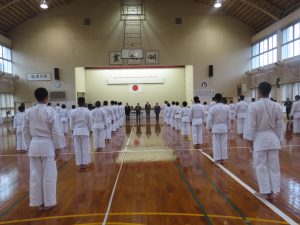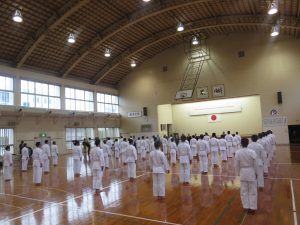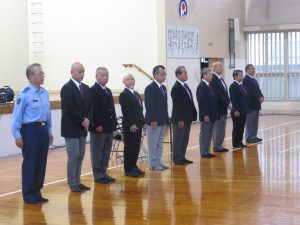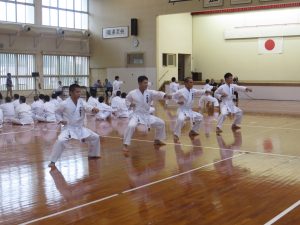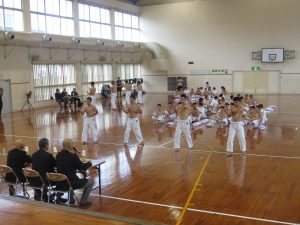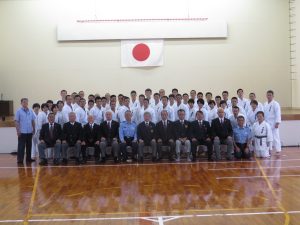Karate policemen protecting the safety and security of Okinawan citizens
On August 29th, the Okinawa Prefectural Police School in Ishikawa City held the first dan grading test under the supervision of the Okinawa Prefecture Karate Federation (OKF).
When speaking of karate and police in Okinawa, the names of teachers such as Nagamine Shōshin sensei (Matsubayashi-ryū), Miyagi Chōjun and Miyazato Eiichi (Gōjū-ryū), and Komesu Kiyoshi (Uechi-ryū) come to mind. All four were active as police officers and instructors, and are remembered as grand masters of Okinawa karate. (1)
In the Japanese police, police academy students study jūdō or kendō and must achieve 1st dan to graduate. After graduation, the practice of one or the other continues.
However, in the birthplace of karate that is Okinawa, men and women who join the police school train hard not only in jūdō or kendō but also in Okinawa traditional karate.
The introduction of karate to the prefectural police school goes back to 2013. At that time, assistant inspector and Gōjū-ryū 6th dan Yogi Jisshō was in charge of the karate instruction. Later, Miyakozawa Takayuki, him too a Gōjū-ryū practitioner and police officer took charge of the instruction, but since there was no official instructor position in the school, the teaching underwent a gap of about two years.
“In order to continue karate training in the school, it is necessary to dispatch instructors regardless of the internal transfer within the force. Also, there is a need to introduce a grading examination system that will set a goal for the students and will lead to continuation.” The one who speaks is the Assistant Commissioner and Chief Inspection Officer of the Okinawa Prefectural Police Headquarters, Matsusaki Yoshimitsu. He is also an 8th dan in Uechi-ryū Karatedō Kenyūkai.
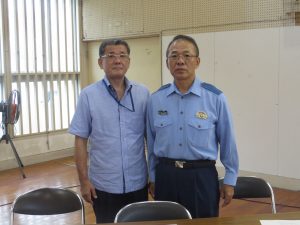 (Mr. Matsusaki and the principal, Mr. Tomiyama)
(Mr. Matsusaki and the principal, Mr. Tomiyama)
Mr. Matsusaki found out about the “2019 Okinawa karate instructors dispatching (promotion within the Prefecture) Project” (2), a project funded by the Prefectural Karate Promotion Division. In order to revive karate instruction within the police academy, he consulted the division’s head Yamakawa Tetsuo, and with the understanding and cooperation of Tomiyama Katsuo, academy prinicpal and Kendō 7th dan, karate instruction started again at the academy on June 5th.
Then, with Uechi-ryū Kenyūkai Higa Susumu as main instructor, short-term students (university graduates) and long-term students (others) were guided in a karate curriculum based on Uechi-ryū Sanchin, kote-kitae and kashi-kitae (forearm conditioning and leg and shin conditioning), Fukkyū-gata I & II, etc.
Seeing the students on the first day and the mood in the gym, an instructor recalls thinking “that won’t work!” However, all 47 short-term students (including 10 women) train hard and on August 29th, they were authorized to stand in front of a grading panel composed of 9 judges from the OKF among which President Taira Yoshitaka, Matsubayashi-ryū Hanshi 10th dan.
The contents of the examination were kihon-dōsa or basic moves, Fukkyū-gata I & II, Sanbon kumite, Sanchin, kote-kitae and kashi-kitae. Divided into 3 courts, everyone showed the results of daily practice. As a result, 39 out of 47 passed.
Compared to jūdō or kendō, karate is still not the officially part of the academy’s curriculum, so the judges received the following instruction from Mr. Matsusaki: “Do not hesitate to not pass students with an unsatisfactory level!”. So doing, the value of the OKF 1st dan was preserved.
OKF’s vice-president and chairman of the Kenyūkai, Shinjō Kiyohide ended the grading with the following words. “Even for powerful people like you, there was too little training time. Even if some of you lack the technique and could not pass, I hope you will become kind-hearted police officers who understand pain.”
Nevertheless, the academy’s short-term students grew up into fine karateka in just 20 hours of training from June to August. The few unsuccessful ones vowed to do their best for the next test.
Long-term students will continue to study karate once or twice a week until December. Of course, jūdō or kendō and taiho-jutsu are also a requirement, and karate training is only an additional training.
During the evaluation gathering, OKF president Taira Yoshitaka who is a top disciple of Nagamine Shōshin, the founder of Matsubayashi-ryū commented: “Karate training was introduced to the Ryūkyū Police in 1918. Considering how to face a bad evil, karate comes as a support. For students who have not experienced a real fight, forearms and lower limbs conditioning and punches to the stomach is a way to understand pain. By not being upset, they will be able to make correct decisions. Training also leads to confidence. I am grateful for the introduction of karate in the prefectural police academy.”
“In June in Osaka, there was a case where a police officer was stabbed. I would like you to raise strong police officers through karate and its spirit of Sente nashi (3)” commented principal Tomiyama.
From now on, police academy students will continue to protect the safety and security of Okinawan citizens with their fists and hearts polished through the training of traditional Okinawan karate.
Notes 1
Master Nagamine Shōshin (1907-11997) was appointed police officer of the Okinawa Prefecture in December 1931, and his first assignment was at Kadena Police Station in central Okinawa. While working there for two years, he studied under Kyan Chotoku. Later, when he was dispatched to the Tōkyō Metropolitan Police Department as a research officer (April 1936), he studied under Motobu Choki for more than half a year. Nagamine retired from being a long-time police officer, and in January 1953 built a full-fledged karate dōjō named the “Matsubayashi-ryū Karatedō Kōdōkan” in Naha City. (Reference: Okinawa Karate Kobudō Encyclopedia, Nagamine Karate Dōjō website).
Master Miyagi Chōjun (1888-1953) began teaching martial arts at the Okinawa Prefectural Police Academy from 1922. In 1946, he became a karate instructor at the Okinawa Police Academy established in Gushikawa. (Reference: Okinawa Karate Kobudō Dictionary).
Master Miyazato Eiichi (1922-1999) studied under Miyagi Chōjun sensei in Matsuo, Naha City from 17 years old. During his time as a police officer, he assists master Miyagi and instructed at the police academy. (Reference: Okinawa Gōjū-ryū Karatedō Association website)
Komesu Kiyoshi (1942 ~circa 1980) studied under master Uechi Kanei, and according to a high-ranking senior of this system, “When people think of a police officer practicing Uechi-ryū, he was the hero of his time”. Retired in his late 20ies, he opened a dōjō in Tōkyō Hachioji. Later handing it to Mr. Shimoji Yasuo, he came back to Okinawa and open a new dōjō in Shuri Sakashita.
Note 2
Through the “2019 Okinawa karate instructors dispatching (promotion within the Prefecture) Project”, instructors will be dispatched for workshops in the Miyako and Yaeyama areas, and seminars, lectures and other related karate programs will be organized according to the needs of various organizations.
Note 3
Karate ni sente nashi, there is no first attack (or offensive intention) in karate.
